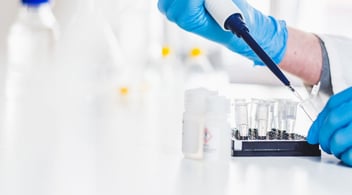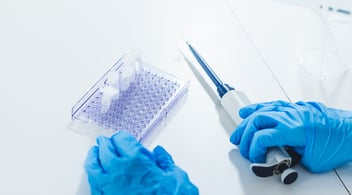During molecular cloning, it is often necessary to do restriction digests, either to excise a fragment of interest from your source DNA, linearize your plasmid vector or to check positive clones.
During this technique the DNA is cleaved at specific recognition sites by restriction enzymes. However, the restriction digest can fail for a variety of reasons. The critical factors include; the composition of the buffer, incubation temperature, DNA methylation, star activity, multiple digestion steps, and the DNA substrate itself.

Below we list some of the common problems you may encounter, their cause, and how to solve them.
Problem: Incomplete digestion or no digestion
Possible Cause: Salt Inhibition.
Solution: Some enzymes are less active in the presence of high salt concentrations. Evaporation during the incubation can increase the salt concentration and affect the enzyme activity. Clean up your DNA prior to digestion.
Possible Cause: Impure DNA.
Solution: DNA preparations may contain other contaminants like phenol, chloroform and ethanol, that partially or completely inhibit the enzyme activity. Clean up your DNA prior to digestion.
Possible Cause: Incompatible buffer.
Solution: Use a recommended buffer supplied with the restriction enzyme. For double digests, follow the manufacturer’s recommendations for optimal buffer compatibility.
Possible Cause: Too few units of enzyme.
Solution: Use at least 3-5 units of enzyme per µg of DNA.
Possible Cause: Incubation time too short
Solution: Increase the incubation time.
Possible Cause: Inactive enzyme.
Solution: Check the expiration date and make sure the enzyme was not stored under -20 °C. Below -20 °C the enzyme will freeze – multiple freeze-thaw cycles can also influence the activity of your enzyme.
Possible Cause: Missing additives or cofactors.
Solution: For optimal enzyme activity, make sure that you add the appropriate cofactors or additives (DTT, Mg2+, ATP).
Possible Cause: Temperature is not optimal.
Solution: Perform the incubation step at the recommended temperature for the enzyme. When doing double digestions, complete the lower-temperature digestion step first, before the higher temperature step.
Possible Cause: Incorrect enzyme dilution buffer.
Solution: Dilute the enzyme with appropriate dilution buffer for restriction enzymes. Never use water or 10X reaction buffer.
Possible Cause: Improper reaction assembly.
Solution: The enzyme should always be the last component added to the reaction mixture. If the enzyme is added directly to the 10X reaction buffer, it may be inactivated.
Possible Cause: Excess glycerol in the reaction mixture.
Solution: The glycerol concentration should be less than 5 %.
Possible Cause: DNA concentration not optimal.
Solution: Ensure that the DNA concentration is in the range of 20-100 ng/µl.
Possible Cause: Restriction enzyme recognition sequence is not present in the substrate DNA.
Solution: Re-check the sequence of your template DNA.
Possible Cause: Methylation effects.
Solution: Check the enzyme's sensitivity to methylation. If it is affected by methylation, look for isoschizomers, which are specific to the same recognition sequence. To avoid DNA methylation, propagate plasmids in E. coli that are dam-/dcm-.
Possible Cause: Incorrect incubation temperature.
Solution: Most restriction enzymes optimally cut DNA at 37 °C but there are many exceptions. Incubate your digest reaction at the recommended temperature.
Possible Cause: Water impurities.
Solution: Perform a negative control containing water, to determine the presence of nuclease or bacterial contaminants. Always use fresh, molecular biology-grade water.
Problem: Unexpected cleavage pattern
Possible Cause: Partial restriction enzyme digests.
Solution: Contamination with inhibitors, or high salt concentrations can affect the digestion reaction. Clean up the DNA before beginning the restriction digest.
Possible Cause: Star activity.
Solution: In some cases restriction enzymes cleave sequences which are similar, but not identical to their defined recognition sequence. Reduce the units of the restriction enzyme and use the recommended reaction buffer.
Possible Cause: Contamination with another enzyme.
Solution: Your buffer or enzyme might be contaminated with another enzyme. Use a fresh tube of buffer and/or enzyme.
Possible Cause: Contamination with other substrate DNA.
Solution: The sample DNA contains more than one sequence of DNA. Prepare a new sample of DNA.
Possible Cause: Unexpected recognition sequences in substrate DNA.
Solution: Re-check your cloning strategy and the sequence of your template DNA.
Problem: Diffuse DNA bands
Possible Cause: Poor DNA quality.
Solution: Check the undigested DNA by electrophoresis. If a smear is observed on the gel, re-purify the DNA by spin column or phenol/chloroform extraction and ethanol precipitation.
Possible Cause: Contaminated reagents.
Solution: Reaction components may have been contaminated with nucleases from improper handling, and resulted in DNA degradation. Prepare new reagents, use new enzymes and buffers, or re-purify DNA if necessary.
Planning to repeat this experiment? Consider these tips!
- Place the enzyme immediately on ice after removal from -20°C storage. Heat can cause denaturation of the enzyme and a loss of function
- The amount of restriction enzyme you need depends on the amount of DNA you want to cut. In general: one unit of enzyme cuts 1 µg DNA in a 50 µl reaction in 1 hour
- Make sure the enzyme is the last component added to the reaction mixture
- Do not vortex the restriction enzyme, mix by flicking or pipetting up and down
- Perform a digestion reaction with a standard control DNA, e.g. Lambda DNA
- Always check the reaction conditions – temperature, incubation time, buffer compatibility - recommended by the manufacturer
- Check the DNA on a gel, including the undigested DNA. You can then identify whether something went wrong in the digestion process




